Components
Solar water heating systems collect solar energy from the sun to preheat water so that your gas or electric heater – whether a conventional tank or tankless – does less work. A solar water heating system can be added to almost any water heater. But if your water heater is worn out, you can install a combined-tank system that incorporates the solar preheated-water storage and your water heater.
Unlike most solar electric systems, all solar water heating systems are ‘off grid’. The energy from the sun is stored and used locally. This is why it is important to size a solar water heating system to match your hot water use.
In an overcast sky climate like western Oregon, solar water heating is predominately sized to match the domestic hot water demand in the summer. In clear sky climates like eastern Oregon solar water heating can make a significant contribution to space heating systems that use hot water. Depending on those variables and whether your backup is gas or electric, the system would typically save between 1,500 and 3,000 kilowatt-hours, or 80 to 150 therms of energy, each year.

A typical solar water heating system incorporates a solar collector, circulation pump, storage tank, controller, piping and various valves. There are many different configurations possible, and the choice of design will depend on the purpose of the system, climate, space limitations and many other factors. Solar water heating systems have two main components: the collectors and the plumbing.
Collectors
In the Northwest, solar water heaters typically fall into two basic categories: flat plate collector systems and evacuated tube systems.
Flat Plate Collector Systems have a large, flat surface area (absorber) to maximize exposure to the sun, and has small tubes bonded to it. Fluid runs through the tubes, collecting the heat from the absorber. The sides and bottom of the collector are well-insulated, and glass on top completes the insulation. Water is pumped up through the collector when there is enough sunlight to heat the coils. When conditions are not right for heating water, the pumps turn off and the water drains back to a reservoir to prevent freezing and overheating. Several factors make the collector as efficient as possible. One is the coating on the absorber, which is specially formulated to both absorb as much heat as possible, and to radiate back out as little heat as possible. Another is the glass, which is high-iron and specially coated to let as much light energy as possible through and also prevent as much heat loss as possible.

Example of what a flat plate collector looks like
Evacuated Tubes Systems has a long, skinny absorber that is inside a glass tube. The tube has the air evacuated out of it, which makes it highly insulated—not too different from a thermos used to keep drinks hot. These systems also rely on pumps to move the fluid. The advantage is reduced heat loss from the collector to the surrounding air. This would be important in a climate with cold daytime temperatures where solar heated water is being used for space heating. Evacuated tube systems are generally more expensive than flat plate collectors.

Example of what an evacuated tube system looks like
CONSIDERATIONS:
- Both the flat plate collectors and evacuated tube systems will typically be mounted on your roof.
- Collectors should be located with a clear southern exposure for the best performance.
- Solar water heater systems are more tolerant of shading and shadows than solar electric systems.
Plumbing

Example of a standard tank room
The plumbing of a solar water heater system is divided into two parts. The glycol system which circulates through the roof top collectors, and the potable water system which includes the solar hot water storage tank, the home water heater, and the safety valves and expansion tank.
The glycol loop consists of two insulated pipes running to the roof to allow a pump to circulate the fluid and bring the heat to the water storage tank. A heat exchanger separates the glycol loop from the potable water in the storage tank.
The plumbing in the “tank room” will contain a number of devices, a pump or pumps, temperature gauges, a pressure gauge, a flow meter, a controller, and ports to insert and check the glycol. On the potable side, the anti-scald valve and another temperature gauge will be plumbed in.

In this photo, the large tank is connected to the collector on the roof. The wall mounted tankless water heater will only turn on to heat up the water if it isn’t already hot enough.
Finding a location for a hot water storage tank can be challenging. Ideally, a location next to your hot water heater is best, however, a close location, even if through a wall in another room will work. Some homeowners replace their old tank type hot water heater with a wall mounted tankless water heater, and then use the old water heater space for the solar water heater tank.
